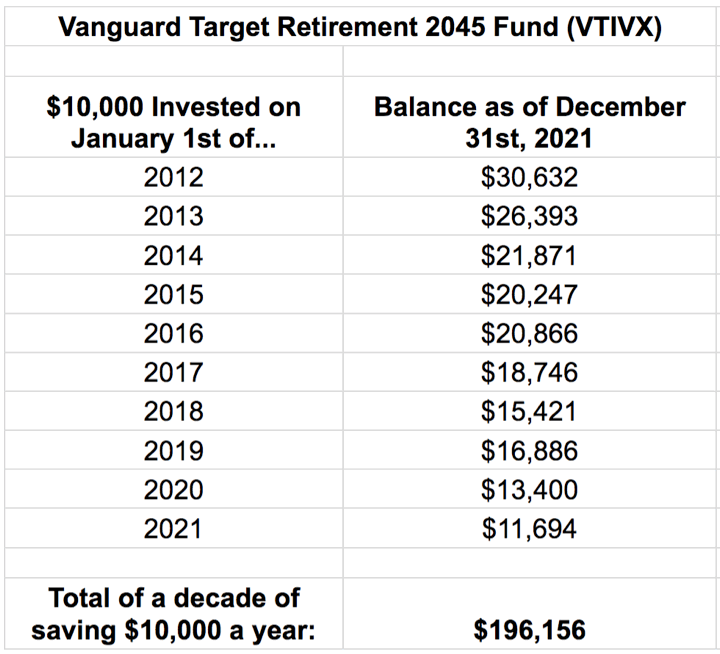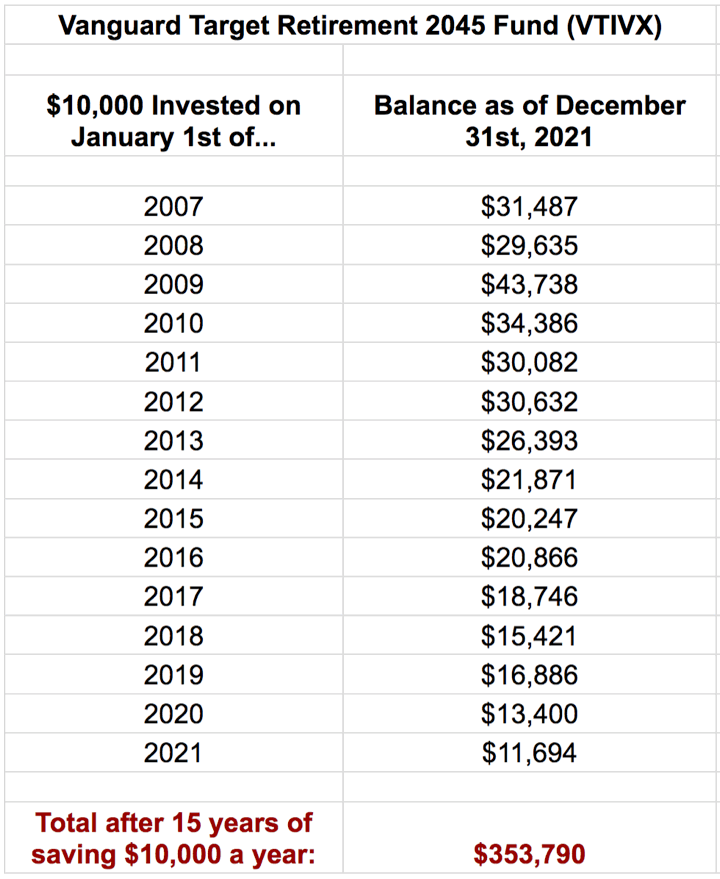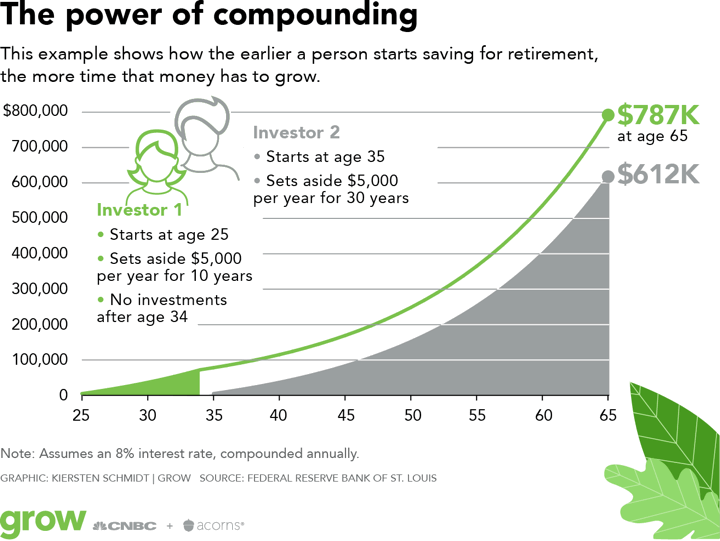 Instead of focusing on the current hot thing, how about stepping back and taking the longer view? How would a steady investor have done over the last decade? Most successful savers invest money each year over a long period of time.
Instead of focusing on the current hot thing, how about stepping back and taking the longer view? How would a steady investor have done over the last decade? Most successful savers invest money each year over a long period of time.
Target date funds. The Vanguard Target Retirement 2045 Fund is an all-in-one fund that is low-cost, globally-diversified, and available both inside many employer retirement plans and to anyone that funds an IRA. When you are young (up until age 40 for those retiring at 65), this fund holds 90% stocks and 10% bonds. It is a solid default choice in a world of mediocre, overpriced options. This is also a good benchmark for others that use low-cost index funds.
The power of consistent, tax-advantaged investing. For the last decade, the maximum allowable annual contribution to a Traditional or Roth IRA has been roughly $5,000 per person. The maximum allowable annual contribution for a 401k, 403b, or TSP plan has been over $10,000 per person. If you have a household income of $67,000, then $10,000 is right at the 15% savings rate mark. Therefore, I’m going to use $10,000 as a benchmark amount. This round number also makes it easy to multiply the results as needed to match your own situation. Save $5,000 a year? Halve the result. Save $20,000 a year? Double the numbers, and so on.
The real-world payoff from a decade of saving $833 a month. What would have happened if you put $10,000 a year into the Vanguard Target Retirement 2045 Fund, every year, for the past 10 years? With the interactive tools at Morningstar and a Google spreadsheet, we get this:

Investing $10,000 every year ($833 a month, or $384 per bi-weekly paycheck) for the last decade would have resulted in a total balance of $196,000. Bump that up to $850 a month, and you’d be sitting on $200,000 right now, broken up into $102,000 in contribution and $98,000 in investment gains.
What would have happened if you extended that to the past 15 years instead? Investing $10,000 every year for the last decade and a half would have resulted in a total balance of $353,000. That breaks down to $150k in contributions + $203k investment growth. Your gains are now officially more than what you initially invested.

Real-world path to becoming a 401(k) millionaire. Not theoretical numbers from a calculator! Are you a dual-income household that can put away more? If you each invested $14,150 a year ($28,300 total for both) for the last 15 years, you would have a million dollars. That means starting at age 22 and ending at 37, or starting at 25 and ending at 40.
It gets even better if you started early. There is a popular example of the power of compound interest that shows how someone who started saving at age 25, saves and invests for 10 years but then stops and never saves a penny again still beats someone who starts saving at 35 and keeps on saving for 30 years. Acorns provides a nice illustration:

Once you have that initial momentum, it just keeps going.
Timing still matters, but not as much as you might think due to the dollar-cost averaging and longer time horizon. Yes, the last decade has been a great run for US stock markets. But Vanguard Target funds also own a lot of international stocks, which haven’t been nearly as hot and have maintained lower valuations. Diversification means you aren’t 100% in the hot thing, but your bases are covered if the hot things goes cold. Here are my previous “saving for a decade” posts:
- 2021 Edition (January 2011 to December 2020)
- 2020 Edition (January 2010 to December 2019)
- 2019 Edition (January 2009 to December 2018)
- 2018 Edition (January 2008 to December 2017)
- 2017 Edition (January 2007 to December 2016)
Work on improving your career skills (or start your own business), save a big chunk of your income, and then invest it in productive assets. Keep calm and repeat. The only “secret” here is consistency and starting as early as you can. (The best time is always yesterday. The second best time is today.) We have maxed out both IRA and the 401k salary deferral limits nearly every year since 2004. We are fortunate in many ways, but we received no inheritance and no house downpayment assistance. We are not super-skilled stock pickers or Bitcoin early adopters. You can still build serious wealth with something as accessible and boring as the Vanguard Target Retirement fund (or a simple collection of low-cost index funds).
 The Best Credit Card Bonus Offers – 2025
The Best Credit Card Bonus Offers – 2025 Big List of Free Stocks from Brokerage Apps
Big List of Free Stocks from Brokerage Apps Best Interest Rates on Cash - 2025
Best Interest Rates on Cash - 2025 Free Credit Scores x 3 + Free Credit Monitoring
Free Credit Scores x 3 + Free Credit Monitoring Best No Fee 0% APR Balance Transfer Offers
Best No Fee 0% APR Balance Transfer Offers Little-Known Cellular Data Plans That Can Save Big Money
Little-Known Cellular Data Plans That Can Save Big Money How To Haggle Your Cable or Direct TV Bill
How To Haggle Your Cable or Direct TV Bill Big List of Free Consumer Data Reports (Credit, Rent, Work)
Big List of Free Consumer Data Reports (Credit, Rent, Work)
A great book along these lines continues to be: “Stocks for the Long Run 5/E: The Definitive Guide to Financial Market Returns & Long-Term Investment Strategies 5th Edition”
But the short of it is basically own equities, and do so for a long time. The flip side is to minimize your expenses, so you need less in the first place while simultaneously saving more.
Johnathan,
Compounding over time is the most stable way to build wealth as you illustrated above. It’s slow and steady and predictable. I’ve read many books published decades ago with the same basic principle. It is frustrating to see there are still people who work hard and could be doing so much better with this one simple concept.
“We are living in an oasis of knowledge but are drowning in a pool of ignorance.”
Agree, Jonathan – thanks for the reminder!
Another concept I think you pointed out: Live beneath your means.
How much money did you make each year, and what were your yearly expenses in order to save these amounts? This sounds good. Am trying to get full picture…..
Our income has varied over the years, but when we started maxing out accounts we were each making between 40k and 60k gross annually.
There are way to get $1000/month to turn into $1M with less risk over the same time period. Mark Spitznagel is a good author to read.